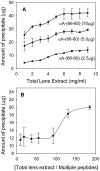αA-crystallin peptide SDRDKFVIFLDVKHF accumulating in aging lens impairs the function of α-crystallin and induces lens protein aggregation
- PMID: 21552534
- PMCID: PMC3084282
- DOI: 10.1371/journal.pone.0019291
αA-crystallin peptide SDRDKFVIFLDVKHF accumulating in aging lens impairs the function of α-crystallin and induces lens protein aggregation
Abstract
Background: The eye lens is composed of fiber cells that are filled with α-, β- and γ-crystallins. The primary function of crystallins is to maintain the clarity of the lens through ordered interactions as well as through the chaperone-like function of α-crystallin. With aging, the chaperone function of α-crystallin decreases, with the concomitant accumulation of water-insoluble, light-scattering oligomers and crystallin-derived peptides. The role of crystallin-derived peptides in age-related lens protein aggregation and insolubilization is not understood.
Methodology/principal findings: We found that αA-crystallin-derived peptide, (66)SDRDKFVIFLDVKHF(80), which accumulates in the aging lens, can inhibit the chaperone activity of α-crystallin and cause aggregation and precipitation of lens crystallins. Age-related change in the concentration of αA-(66-80) peptide was estimated by mass spectrometry. The interaction of the peptide with native crystallin was studied by multi-angle light scattering and fluorescence methods. High molar ratios of peptide-to-crystallin were favourable for aggregation and precipitation. Time-lapse recordings showed that, in the presence of αA-(66-80) peptide, α-crystallin aggregates and functions as a nucleus for protein aggregation, attracting aggregation of additional α-, β- and γ-crystallins. Additionally, the αA-(66-80) peptide shares the principal properties of amyloid peptides, such as β-sheet structure and fibril formation.
Conclusions/significance: These results suggest that crystallin-derived peptides such as αA-(66-80), generated in vivo, can induce age-related lens changes by disrupting the structure and organization of crystallins, leading to their insolubilization. The accumulation of such peptides in aging lenses may explain a novel mechanism for age-related crystallin aggregation and cataractogenesis.
Conflict of interest statement
Figures








Similar articles
-
Significance of interactions of low molecular weight crystallin fragments in lens aging and cataract formation.J Biol Chem. 2008 Mar 28;283(13):8477-85. doi: 10.1074/jbc.M705876200. Epub 2008 Jan 28. J Biol Chem. 2008. PMID: 18227073 Free PMC article.
-
A single Asp isomer substitution in an αA-crystallin-derived peptide induces a large change in peptide properties.Exp Eye Res. 2020 Mar;192:107930. doi: 10.1016/j.exer.2020.107930. Epub 2020 Jan 10. Exp Eye Res. 2020. PMID: 31931001
-
The αA66-80 peptide interacts with soluble α-crystallin and induces its aggregation and precipitation: a contribution to age-related cataract formation.Biochemistry. 2013 May 28;52(21):3638-50. doi: 10.1021/bi301662w. Epub 2013 May 16. Biochemistry. 2013. PMID: 23631441 Free PMC article.
-
Effects of alpha-crystallin on lens cell function and cataract pathology.Curr Mol Med. 2009 Sep;9(7):887-92. doi: 10.2174/156652409789105598. Curr Mol Med. 2009. PMID: 19860667 Review.
-
Structure and function of α-crystallins: Traversing from in vitro to in vivo.Biochim Biophys Acta. 2016 Jan;1860(1 Pt B):149-66. doi: 10.1016/j.bbagen.2015.06.008. Epub 2015 Jun 25. Biochim Biophys Acta. 2016. PMID: 26116912 Review.
Cited by
-
Protein misfolding and aggregation in cataract disease and prospects for prevention.Trends Mol Med. 2012 May;18(5):273-82. doi: 10.1016/j.molmed.2012.03.005. Epub 2012 Apr 19. Trends Mol Med. 2012. PMID: 22520268 Free PMC article. Review.
-
Imaging Cataract-Specific Peptides in Human Lenses.Cells. 2022 Dec 14;11(24):4042. doi: 10.3390/cells11244042. Cells. 2022. PMID: 36552806 Free PMC article.
-
Development of a brain-permeable peptide nanofiber that prevents aggregation of Alzheimer pathogenic proteins.PLoS One. 2020 Jul 24;15(7):e0235979. doi: 10.1371/journal.pone.0235979. eCollection 2020. PLoS One. 2020. PMID: 32706773 Free PMC article.
-
Interaction of Alpha-Crystallin with Phospholipid Membranes.Curr Eye Res. 2021 Feb;46(2):185-194. doi: 10.1080/02713683.2020.1786131. Epub 2020 Jul 12. Curr Eye Res. 2021. PMID: 32564617 Free PMC article.
-
Cholesterol and Q147E Deamidation Modulates αA-Crystallin Membrane Binding Elucidating Protective Role of Lens Membrane Composition Changes With Aging.Invest Ophthalmol Vis Sci. 2025 May 1;66(5):8. doi: 10.1167/iovs.66.5.8. Invest Ophthalmol Vis Sci. 2025. PMID: 40323268 Free PMC article.
References
-
- Bloemendal H, de Jong W, Jaenicke R, Lubsen NH, Slingsby C, et al. Ageing and vision: structure, stability and function of lens crystallins. Prog Biophys Mol Biol. 2004;86:407–485. - PubMed
-
- Horwitz J, Emmons T, Takemoto L. The ability of lens alpha crystallin to protect against heat-induced aggregation is age-dependent. Curr Eye Res. 1992;11:817–822. - PubMed
-
- Bron AJ, Vrensen GF, Koretz J, Maraini G, Harding JJ. The ageing lens. Ophthalmologica. 2000;214:86–104. - PubMed
Publication types
MeSH terms
Substances
Grants and funding
LinkOut - more resources
Full Text Sources
Medical

